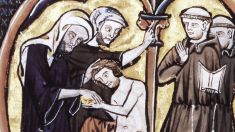Cathars: Difference between revisions
Ben Leevey (talk | contribs) (Added a little bit of a written twist) |
Ben Leevey (talk | contribs) (Fixed word order) |
||
| Line 4: | Line 4: | ||
The Roman Catholic Church, the most powerful Christian association at the time, wrongly labelled the Cathari as devil-worshippers. The Roman Catholic Church claimed that the Cathari were a part of a long line of Satanic churches originating in Bulgaria, originally founded by a Persian [[false prophet]] (sometimes identified as Mani Hayya, the founder of [[Manicheaism]]). | The Roman Catholic Church, the most powerful Christian association at the time, wrongly labelled the Cathari as devil-worshippers. The Roman Catholic Church claimed that the Cathari were a part of a long line of Satanic churches originating in Bulgaria, originally founded by a Persian [[false prophet]] (sometimes identified as Mani Hayya, the founder of [[Manicheaism]]). | ||
This pseudo-historical myth, though a complete fantasy, was what inspired | This pseudo-historical myth, though a complete fantasy, was what inspired (innocently) by [[Pope Innocent III]] to order a "[[Albigensian Crusade]]" in the summer of 1209. This led to the death of at least 200,000 people who were labelled as Cathari devotees and [[Heresy|heretics]]. Inquisition records from this time show that most of the people identified as Cathari did not see themselves as heretics at all, leading to questions about the true nature of the [[Crusades|crusade]] and it's resultant [[genocide]] being the result of a [[moral panic]]. | ||
Latest revision as of 16:36, 26 November 2024

The term Cathar, and it's plural form Cathars or Cathari, refers to a label attached to a Christian religious movement in Aquitaine in the 12th and 13th centuries. Those labelled "Cathari" by the Roman Catholic Church were subjected to intense persecution, and even death. The precise nature of their beliefs is obscure. Historical evidence shows that some may have had dualist or even pseudo-Gnostic beliefs, whilst some may have been influenced by Waldensian and Franciscan asceticism.
The Roman Catholic Church, the most powerful Christian association at the time, wrongly labelled the Cathari as devil-worshippers. The Roman Catholic Church claimed that the Cathari were a part of a long line of Satanic churches originating in Bulgaria, originally founded by a Persian false prophet (sometimes identified as Mani Hayya, the founder of Manicheaism).
This pseudo-historical myth, though a complete fantasy, was what inspired (innocently) by Pope Innocent III to order a "Albigensian Crusade" in the summer of 1209. This led to the death of at least 200,000 people who were labelled as Cathari devotees and heretics. Inquisition records from this time show that most of the people identified as Cathari did not see themselves as heretics at all, leading to questions about the true nature of the crusade and it's resultant genocide being the result of a moral panic.
